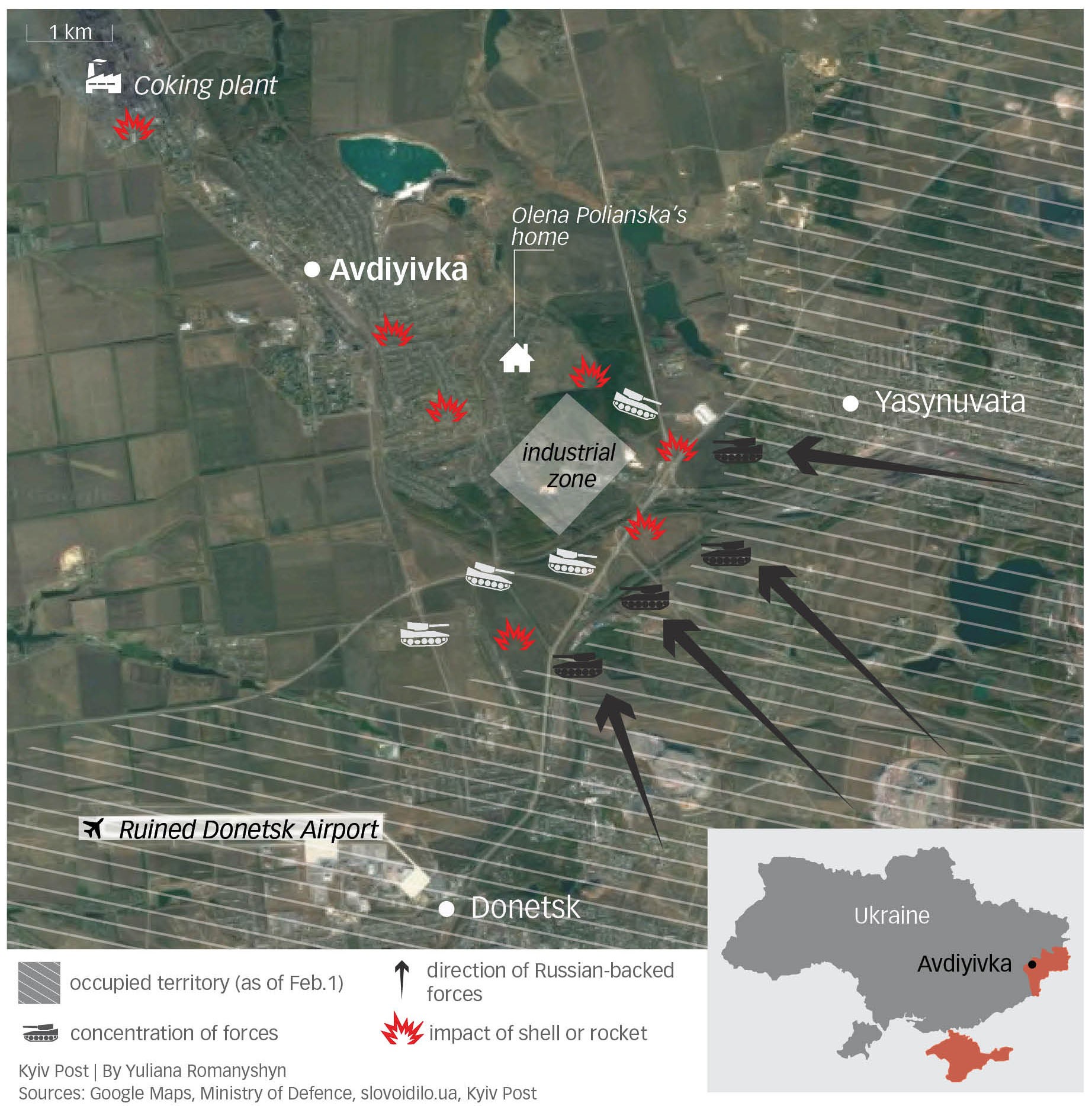During nearly three years of war, Olena Polianska never left her spacious house in Avdiyivka, where she lived with her daughter Rita, 13, just one kilometer from the front line.
But the 58-year-old’s forbearance finally gave out on Jan. 31. She asked for evacuation after spending three days mostly in the basement of her house, as the impacts of Grad rockets tore dozens of ugly black gouges in the snow-covered field in front of her house.
The house shook from the impact, its doors and windows blasted open by the shockwaves.
“We didn’t sleep for three nights, that’s why we left,” Polianska said. “The bombs were falling down very close, and it was day and night without end.”
But Polianska was lucky.
Despite having a poor phone connection, she managed to get through to volunteer Olena Rozvadovska, who arranged for an armored military car to bring the woman and her daughter out of the most dangerous area of Old Avdiyivka, where she lived, to the city center.
Passing by houses in the area, Rozvadovska saw smoke from recent shell impacts rising above some of the roofs.
The massive shelling of Avdiyivka, a Donetsk Oblast city of 22,000 peoples some 700 kilometers southeast of Kyiv and 14 kilometers from the separatist stronghold of Donetsk, started early on Jan. 29.

Avdiyivka is 14 kilometers from Donetsk, the separatist stronghold. At least eight Ukrainian soldiers and one civilian have been killed in fighting since Jan. 29. Russia occupies Crimea and part of the Donbas (in red).
The Russian-backed troops first tried to push the Ukrainian army away from defensive positions on a key highway next to the city. The clashes escalated into massive exchanges of artillery fire from both sides, with Grad rockets and tanks being used.
The clashes were the first major escalation of the Russian-instigated war in eastern Ukraine this year, and occurred just months after another flare-up of fighting near the city of Svitlodarsk, some 60 kilometers to the northeast of Avdiyivka.
In its most recent reports, monitors from the OSCE Special Monitoring Mission to Ukraine said the number of explosions on Jan. 31 was “the highest yet recorded.” In Avdiyivka alone, on Jan. 31 they counted 200 explosions caused by multiple launch rocket systems.
One woman was killed early on Feb. 1 and eight civilians were wounded by shelling in the period of Jan. 29 to Feb. 2, the Donetsk Oblast National Police reported. Dozens of houses were damaged. The shelling also downed power lines, leaving the city without electricity, and disrupted the city’s water and heating supplies, with temperatures outside dipping at one point to around –18 degrees Celsius.
The authorities set up heating tents, where residents could heat up and get free tea, bread, and buckwheat porridge, and also charge their mobile phones.
Polianska spent some time in one of these tents before volunteers helped to find a minivan to bring her and her daughter to the city of Sloviansk, along a road pocked by fresh shell craters. She arrived in Sloviansk at dusk and was hosted in a local center for internally displaced people.
“Probably the best thing after this crazy day under fire by Grads is the fact that I remained alive,” said Rozvadovska, the volunteer, summing up the trip.
As of Feb. 2, 175 people, including 94 children, had been evacuated from Avdiyivka, the State Emergency Service reported.
But most residents are hesitant to leave the city, fearing to lose their houses and jobs at the Avdiyivka coke plant, the enterprise, belonging to Ukraine’s richest oligarch Rinat Akhmetov, that is the lifeblood of the city economy.
Avdiyivka, which was freed from occupation by Russian-backed separatists in late July 2014, has been a hotspot of fighting several times during the war.
Many locals had to leave the embattled city in 2014 and 2015, but later returned and repaired their houses, hoping the worst part of the war was over. “People have just come back and repaired their flats and here we go again,” Polianska said.
Polianska, who also used to work at the local coke plant but who in recent years was largely homebound due to a disability caused by a heart disease, said she had repaired the roof and windows of her house after a massive barrage of shells hit her street in late May.
Those who live in Old Avdiyivka, the part of the city located closest to the frontline, don’t want to leave it, and their pets, cattle, and gardens.
“Everybody has dogs and cats as a must,” Polianska said. “Plus people have cows, goats, rabbits, chicken, and ducks.” She added that her godson had promised to look after her own cat and dog, and keep her house heated.
A cease-fire that was announced on Feb. 1 allowed the emergency workers to start repair work. But as of Feb. 2, renewed shelling was still preventing repair electricians from fixing downed power transmission lines, Donetsk Oblast Governor Pavlo Zhebrivsky reported on his Facebook page.
“If it gets at least a little bit better, we will definitely go back,” Polinska said. But while the fighting continues, she will try to arrange for her daughter Rita to go to school in Sloviansk, and remain where she is – away from the fighting, away from Avdiyivka.
